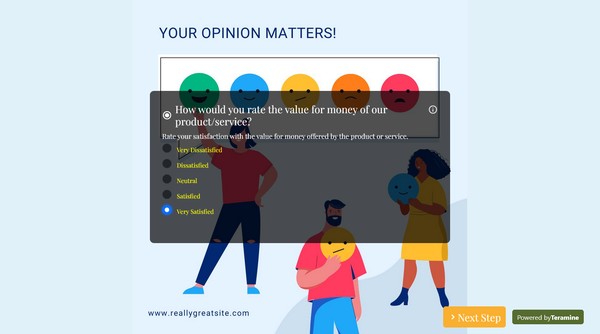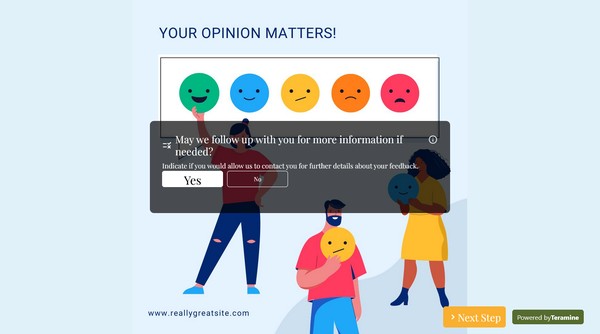Customer Satisfaction Score Form

Incorporating a Customer Satisfaction Score (CSAT) Form on your website or social media platforms offers numerous advantages, including:
- Improved Customer Insights: Gain a deeper understanding of customer experiences, preferences, and areas for improvement.
- Enhanced Engagement: Demonstrate your commitment to customer satisfaction by actively soliciting and valuing their feedback.
- Data-Driven Decisions: Utilize collected data to inform product development, marketing strategies, and customer service enhancements.
- Increased Customer Loyalty: Addressing customer concerns and acting on feedback can strengthen customer trust and loyalty.
- Competitive Advantage: Stay ahead of competitors by continuously improving your offerings based on real customer insights.
- Efficiency: Automate feedback collection processes, reducing the workload on customer service teams and ensuring a streamlined approach.
By adding a CSAT form, you empower your business to evolve, refine, and succeed based on what truly matters—your customers.












Customer Satisfaction Score Form FAQs
A Customer Satisfaction Score (CSAT) form is a survey tool utilized by businesses to measure customer satisfaction regarding their products, services, or overall brand experience. Typically, this form includes a series of questions designed to gauge how well the business meets customer expectations and to identify areas for improvement.
Key components of a CSAT form generally include:
Rating Scale: Most CSAT forms employ a simple rating scale, often ranging from 1 to 5 or 1 to 10, where customers can express their level of satisfaction. For instance, a score of 1 may represent "very dissatisfied," while a score of 5 or 10 indicates "very satisfied."
Specific Questions: The form may include targeted questions that address various aspects of the customer experience, such as product quality, customer service, delivery efficiency, and overall value for money.
Open-Ended Feedback: To capture more nuanced insights, CSAT forms often include a section for open-ended responses, allowing customers to elaborate on their ratings and provide suggestions for improvement.
Demographic Information: Collecting basic demographic data can help businesses understand the context of customer feedback and identify trends among different customer segments.
Follow-Up Mechanism: Many organizations use the insights gained from CSAT forms to implement follow-up procedures, such as outreach to dissatisfied customers or initiatives aimed at enhancing specific service areas.
By analyzing the results of a CSAT form, businesses can make informed decisions to enhance customer experiences, foster loyalty, and ultimately drive revenue growth. The consistent use of CSAT forms contributes to a culture of continuous improvement within customer-facing operations.
A Customer Satisfaction Score (CSAT) form is a crucial tool for gathering feedback on customers' experiences with your product or service. To ensure that the form is effective and provides actionable insights, it should contain the following key elements:
Clear Introduction:
- A brief overview of the purpose of the survey.
- An assurance of anonymity and confidentiality, if applicable.
Rating Scale:
- A defined scale, typically ranging from 1 to 5 or 1 to 10, where respondents can easily indicate their level of satisfaction. For example, 1 could represent "very dissatisfied" and 5 or 10 represent "very satisfied."
Specific Questions:
- Direct questions pertaining to different aspects of the customer experience, such as:
- Overall satisfaction with the product/service.
- Satisfaction with customer service interactions.
- The ease of the purchasing process.
- Product quality and performance.
- Value for money.
- Direct questions pertaining to different aspects of the customer experience, such as:
Open-Ended Feedback:
- A section for customers to provide qualitative feedback or suggestions. This allows for deeper insights into their experiences and makes customers feel heard.
Demographic Information (optional):
- Basic demographic questions such as age, location, or frequency of purchase (if relevant) can help you analyze trends across different customer segments.
Net Promoter Score (NPS) Question (optional):
- Including a question on how likely customers are to recommend your product/service to others can provide further insight into customer loyalty.
Follow-Up Permission:
- An option for customers to consent to be contacted for follow-up questions or further discussion about their feedback.
Closing Statement:
- A thank-you note expressing appreciation for the customer's time and input, reinforcing the importance of their feedback.
Estimated Completion Time:
- A note indicating how long the survey will take to complete, encouraging participation.
By structuring the CSAT form with these components, businesses can effectively gather valuable feedback that can inform improvements and enhance overall customer satisfaction.
Utilizing a Customer Satisfaction Score (CSAT) form offers several compelling advantages for your business:
Quantifiable Insights: A CSAT form provides measurable data regarding customer satisfaction, enabling you to quantify their experiences and gauge overall sentiment regarding your products or services.
Identifying Strengths and Weaknesses: By collecting feedback, you can pinpoint specific areas where your business excels and where improvements are necessary. This targeted approach allows for strategic enhancement of products, services, or customer interactions.
Enhancing Customer Loyalty: Regularly assessing customer satisfaction shows your commitment to providing an exceptional experience. This can lead to improved customer loyalty and retention, as clients appreciate being heard and valued.
Informed Decision-Making: The data derived from CSAT forms can inform strategic decisions, marketing efforts, and operational adjustments. This aligns your business initiatives more closely with customer expectations and preferences.
Benchmarking Performance: Tracking CSAT scores over time allows you to benchmark your performance against industry standards or historical data. This aids in assessing the effectiveness of changes made within the organization.
Encouraging Continuous Improvement: Regularly soliciting feedback fosters a culture of continuous improvement, as it encourages your team to remain vigilant in addressing customer needs and enhancing the overall service experience.
In summary, utilizing a Customer Satisfaction Score Form is an essential tool for any business looking to enhance customer relations, inform strategic decisions, and drive long-term success.










